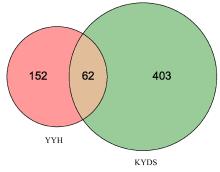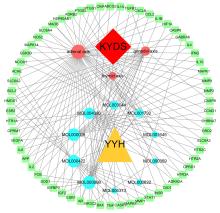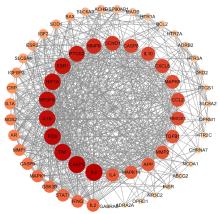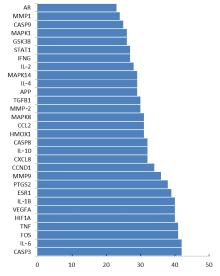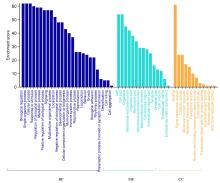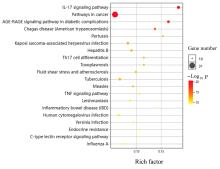| 1 |
程 芬, 杨长花, 宋艳丽, 等. 盐炙杜仲对大鼠肾阳虚的影响及机制研究[J]. 中国药房, 2022, 33(12): 1460-1465.
|
| 2 |
白璐铭, 尚德阳. 肾阳虚证病位证候要素探析[J]. 辽宁中医药大学学报, 2022, 24(9): 199-202.
|
| 3 |
NAN Y, ZHOU X H, LIU Q, et al. Serum metabolomics strategy for understanding pharmacological effects of ShenQi pill acting on kidney Yang deficiency syndrome[J]. J Chromatogr B Analyt Technol Biomed Life Sci, 2016, 1026: 217-226.
|
| 4 |
张 涛, 徐福如, 蒋文君, 等. 电针肾俞穴对肾阳虚豚鼠形态行为及血清激素的影响[J]. 中国中西医结合杂志, 2020, 40(6): 703-707.
|
| 5 |
陈颖颖, 罗 静, 徐 愿, 等. 肾阳虚动物模型造模方法评价及进展[J]. 中华中医药学刊, 2018, 36(11): 2697-2700.
|
| 6 |
褚怡中. 早发性卵巢功能不全患者血清炎症因子与中医证型的相关性研究[D]. 南京: 南京中医药大学, 2022.
|
| 7 |
CHEN R Q, WANG J, ZHAN R H, et al. Integrated systems pharmacology, urinary metabonomics, and quantitative real-time PCR analysis to uncover targets and metabolic pathways of the you-Gui pill in treating kidney-Yang deficiency syndrome[J]. Int J Mol Sci, 2019, 20(15): 3655.
|
| 8 |
刘发元, 李西海, 叶蕻芝, 等. 独活寄生汤干预骨关节炎软骨细胞凋亡的机制[J]. 中华中医药杂志, 2014, 29(7): 2165-2168.
|
| 9 |
王焕珍, 柴艺汇, 陈云志, 等. 淫羊藿化学成分与药理作用研究进展[J]. 亚太传统医药, 2016, 12(7): 63-65.
|
| 10 |
姜庆虎, 刘 峰, 于东悦, 等. 基于高光谱分析的淫羊藿药用成分快速检测研究[J]. 光谱学与光谱分析, 2022, 42(5): 1445-1450.
|
| 11 |
ZHOU M, ZHENG W, SUN X G, et al. Comparative analysis of chemical components in different parts of Epimedium Herb[J]. J Pharm Biomed Anal, 2021, 198: 113984.
|
| 12 |
周晓洁, 姚辛敏, 周妍妍. 淫羊藿的药理作用研究进展[J]. 中医药学报, 2022, 50(11): 112-115.
|
| 13 |
方春燕, 叶玉龙, 叶乃菁, 等. 基于网络药理学与分子对接技术研究淫羊藿治疗少弱精症的作用机制[J]. 中国实验方剂学杂志, 2022, 28(19): 194-203.
|
| 14 |
龚明峰, 张志刚. 四川不同产地淫羊藿补肾壮阳作用研究[J]. 湖北中医杂志, 2019, 41(9): 56-58.
|
| 15 |
胡浩武, 高 羽, 周青罡, 等. 不同基原淫羊藿补肾壮阳相关药效学比较研究[J]. 江西中医药, 2022,53(8): 59-62.
|
| 16 |
李兰兰, 徐 磊, 李利超, 等. 淫羊藿治疗男性不育症的作用机制研究进展[J]. 辽宁中医药大学学报, 2022, 24(8): 40-44.
|
| 17 |
HUANG D X, YANG J, LU X M, et al. An integrated plasma and urinary metabonomic study using UHPLC-MS: intervention effects of Epimedium koreanum on ‘Kidney-Yang Deficiency syndrome’ rats[J]. J Pharm Biomed Anal, 2013, 76: 200-206.
|
| 18 |
张懿丹, 麦婷婷, 倪喆鑫, 等. 基于网络药理学探讨淫羊藿补肾作用对多囊卵巢综合征的影响[J]. 国际中医中药杂志, 2021, 43(8): 796-802.
|
| 19 |
CHO J H, JUNG J Y, LEE B J, et al. Epimedii herba: a promising herbal medicine for neuroplasticity[J]. Phytother Res, 2017, 31(6): 838-848.
|
| 20 |
牛 明, 张斯琴, 张 博, 等. 《网络药理学评价方法指南》解读[J]. 中草药, 2021, 52(14): 4119-4129.
|
| 21 |
李 倩,吴雍真,柴艺汇,等.基于网络药理学研究淫羊藿改善心肌重塑的有效成分和作用机制[J].辽宁中医杂志,2021,48(7):187-191.
|
| 22 |
陈媛媛,李 敏,崔树娜.基于网络药理学的淫羊藿调节免疫耐受作用机制研究[J].扬州大学学报(农业与生命科学版),2022,43(2):69-77.
|
| 23 |
成丽媛,霍香香,杨 莉,等.UPLC法测定不同基源淫羊藿中11种有效成分的含量[J].天津中医药大学学报,2022,41(2):237-242.
|
| 24 |
韩 莹.淫羊藿药材中主要黄酮类成分含量对比研究[J].光明中医,2022,37(6):991-993.
|
| 25 |
武 琦.基于系统生物学的海马补肾丸治疗下丘脑-垂体-肾上腺/性腺/甲状腺轴功能损伤的作用机制研究[D].天津:天津医科大学, 2020.
|
| 26 |
杨 洋,尹程程,陈昊媛,等.不同品种淫羊藿黄酮类有效成分的主成分分析及对下丘脑-垂体-肾上腺/性腺/甲状腺轴功能损伤大鼠保护作用的研究[J].天然产物研究与开发,2021,33(2):179-187.
|
| 27 |
包 宇.淫羊藿总黄酮对下丘脑-垂体-肾上腺/性腺/甲状腺轴功能损伤小鼠肾脏和性腺雄激素受体基因表达的影响[D].西安:陕西师范大学,2007.
|
| 28 |
赵朋飞,马月香,张诺,等.基于网络药理学和分子对接探讨半边莲治疗新型冠状病毒肺炎的潜力[J].华北理工大学学报(自然科学版),2023,45(1):109-118.
|
| 29 |
秦明慧,钱海兵.巫山淫羊藿对甲状腺功能减退大鼠的影响[J].中国处方药,2022,20(5):23-25.
|
| 30 |
曹 莹.基于代谢组学和网络药理学探索左、右归丸辨证治疗卵巢储备功能减退的研究[D].南京:南京中医药大学,2022. *吉林大学药学院 2020级药学专业
|
 ),Weidong ZHANG(
),Weidong ZHANG( )
)
